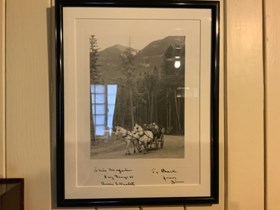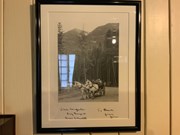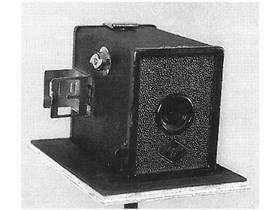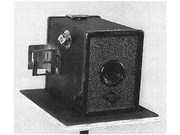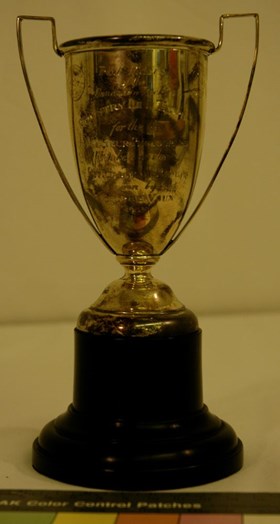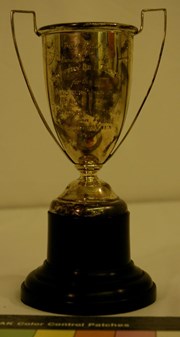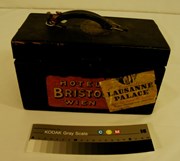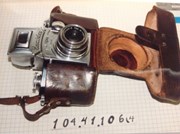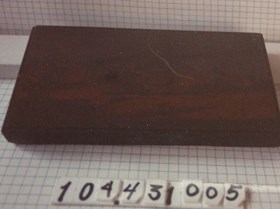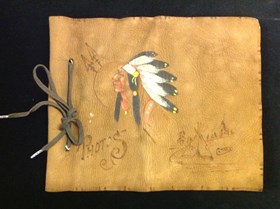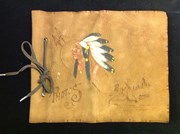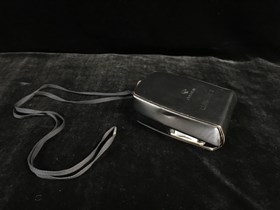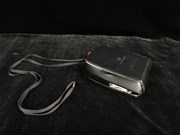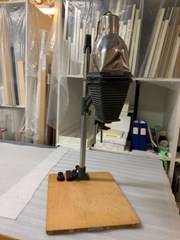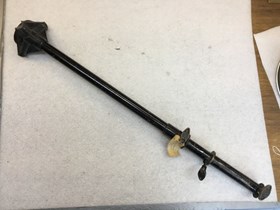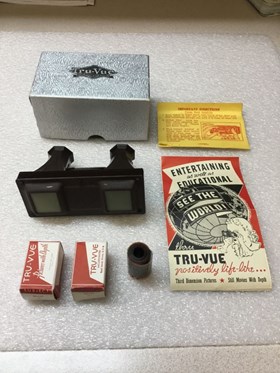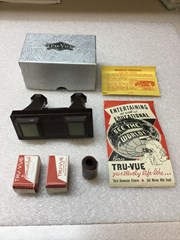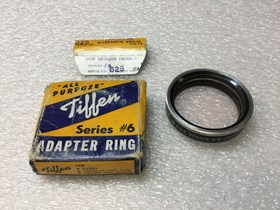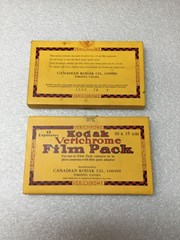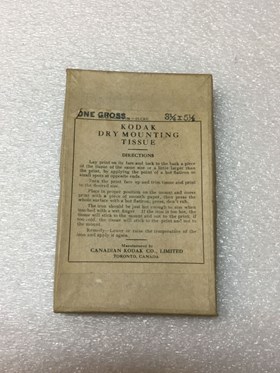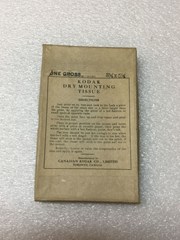Narrow Results By
Photographic Print
https://archives.whyte.org/en/permalink/artifact105.02.0041
- Date
- 1939 – 1939
- Material
- paper; wood; glass; metal
- Catalogue Number
- 105.02.0041
- Description
- A black and white photograph of the King and Queen, in a carriage drawn by two white horses driven by Jim Brewster, with tall trees and mountains in background. The photo has a white mat and a simple black wooden frame. The bottom of the mat is marked “Thier (sic) Majesties King George VI Queen E…
1 image
- Title
- Photographic Print
- Date
- 1939 – 1939
- Material
- paper; wood; glass; metal
- Dimensions
- 22.7; 37.2 (frame) x 17.5; 29.6 (frame) cm
- Description
- A black and white photograph of the King and Queen, in a carriage drawn by two white horses driven by Jim Brewster, with tall trees and mountains in background. The photo has a white mat and a simple black wooden frame. The bottom of the mat is marked “Thier (sic) Majesties King George VI Queen Elizabeth” and “To Pearl from Jim.”
- Credit
- Gift of Pearl Evelyn Moore, Banff, 1979
- Catalogue Number
- 105.02.0041
Images
This material is presented as originally created; it may contain outdated cultural descriptions and
potentially offensive content.
Read more.
- Date
- 1938
- Material
- metal; glass; paper
- Catalogue Number
- 104.41.1113 a,b
- Description
- A simple black box camera with black, simulated textured leather. It also has an adhesive-taped, original box. The inverted aperture in the front has a black metal retention ring surrounding it. Below this “Agfa” is imprinted on the camera, surrounded by a diamond-shaped box. There is a black metal…
1 image
- Title
- Box Camera
- Date
- 1938
- Material
- metal; glass; paper
- Dimensions
- 8.5 x 6.5 cm
- Description
- A simple black box camera with black, simulated textured leather. It also has an adhesive-taped, original box. The inverted aperture in the front has a black metal retention ring surrounding it. Below this “Agfa” is imprinted on the camera, surrounded by a diamond-shaped box. There is a black metal rim which overlaps the edges on the front of the camera; on both sides there is a slight extension, .03 x.05 wide, 2.0cm from the top, with a hole in the metal. This fits over two small metal knobs on each side of the camera body. It appears that pushing the knobs in and pulling, would release the front part of the camera from the body. On the viewer’s left is the metal shutter release; a small metal lever that can be pulled down to release the shutter and expose the lens from inside the body. On the same side is the metal film winder, 3.0cm from the front and .50cm from the top; this is a flat piece of metal 2.0cm in diameter, with arrows indicating the direction to turn (clockwise arrows), a round raised metal tab, onto which is screwed a piece of metal (2.5cmx1.0cm wide in the middle) to wind the film. It can also be pulled out to release the metal film chamber. The metal is turned down on the side of each end so the fingers can grasp it for turning. A metal folding viewfinder is .50cm from the back and 2.7cm from top and bottom; a flat piece of metal 3.0cm sq., folded at the sides, is rivetted onto the body. Two flat metal pieces are attached at each end, one on a spring to fold down; this piece is 2.4x2.7cm wide with a window cut out .50x1.0cm wide. The other piece is 2.7cm sq. with a window of 1.5x2.4cm wide; the cutout has a piece of metal raised from the bottom of the window. The cutout is for perspective when you look through the viewfinder, vertically or horizontally. This piece of metal folds down to become the top, effectively making the viewfinder flat when not in use. There is a hinged door on the back of the camera and a cut-out metal latch on the door that connects to a small metal knob 1.0cm from the edge of the body. There is a red circle film window (1.0cm diagonally) which lets you read the frame number on the film. On the inside of the door are two rivets that connect the hinge. Above that and below the red circle, is a white painted circle with “USE AB” printed in black, overlapping a painted orange, blue, white, and yellow Agfa Plenachrome film box. The red viewfinder is 4.0cm from the base. A metal film chamber, with two metal rollers on each end for winding the film on, fits inside the camera. It can be released by pulling out the film winder. The canister is 7.0x5.0 wide, is open at one end, hollow in the centre, sloping upwards with a circular hole at the other end to let light in. There are two sprockets sitting on two cutouts on top of the canister and two on the bottom, onto which the film is winded. There are two rivets attaching two Y-shaped metal pieces, on either end that guide and let the film move and roll. The top of the camera has two metal knobs 1.5cm crosswise from each end, where a leather strap with a hole on either end, .07cm from the edge, fits in to make a diagonal strap/handle for carrying. The strap is imprinted with “A-8 CADET”. There is a small metal pull-up tab, 1.0cm from the edge of the front of the camera, that lets you time the shutter speed.
- Subject
- households
- photography
- hobbies
- Bob Louden
- Credit
- Gift of Bob Louden, Calgary, 2004
- Catalogue Number
- 104.41.1113 a,b
Images
This material is presented as originally created; it may contain outdated cultural descriptions and
potentially offensive content.
Read more.
- Date
- 1933
- Material
- metal; wood; fabric; paper
- Catalogue Number
- 103.09.1226
- Description
- A two-handled sterling silver trophy cup on a turned wooden base; the cup is in its original blue flannel drawstring bag. A black label with “BIRKS” in gold is stitched to the bag. The engraving on the front of the cup “Trail Riders of the Canadian Rockies” is in italic script, underneath, engraved…
1 image
- Title
- Loving Cup
- Date
- 1933
- Material
- metal; wood; fabric; paper
- Dimensions
- 18.5 x 9.2 cm
- Description
- A two-handled sterling silver trophy cup on a turned wooden base; the cup is in its original blue flannel drawstring bag. A black label with “BIRKS” in gold is stitched to the bag. The engraving on the front of the cup “Trail Riders of the Canadian Rockies” is in italic script, underneath, engraved in an arc in caps “COUNTRY LIFE TROPHY” (all other engraving is printed horizontally) lc italics “for the best”, caps “AMATEUR PHOTOGRAPHY “ lc italics “taken on the”, caps “OFFICIAL TRAIL RIDE”, lc italics “won by”, caps “GEORGE VAUX”, “1933”. The TRCR logo (a circle with a horse and rider in the centre surrounded by a rim in which “TRAIL RIDERS OF THE CANADIAN ROCKIES” is printed) is stamped on both sides of engraved “Trail Riders of the Canadian Rockies”. On the back of the cup near the lip and to the right an engraved “BIRKS” surrounded by a box, ”STERLING”, three silver hallmarks, “66/23”. The handles rise up 1.5 cm. from the lip, 1.5cm. horizontally and then curve down gracefully to the bottom of the cup at the narrowest part. The base of the cup flares out and is attached to a black turned wooden base. The bottom of base is covered by glued on black faux leather (paper).
- Subject
- sports
- riding
- horses
- Trail Riders of the Canadian Rockies
- Country Life Trophy
- George Vaux
- photography
- Credit
- Gift of Molly Vaux, New York, USA, 2007
- Catalogue Number
- 103.09.1226
Images
This material is presented as originally created; it may contain outdated cultural descriptions and
potentially offensive content.
Read more.
- Date
- 1931
- Material
- metal; wood
- Catalogue Number
- 103.09.1183
- Description
- Two handled silver-plated cup on black wooden circular base. Cup engraved: “Trail Riders of the Canadian Rockies Photographic Contest 1931”.
1 image
- Title
- Loving Cup
- Date
- 1931
- Material
- metal; wood
- Dimensions
- 23.0 cm
- Description
- Two handled silver-plated cup on black wooden circular base. Cup engraved: “Trail Riders of the Canadian Rockies Photographic Contest 1931”.
- Credit
- Gift of John Fee, White Rock, 1996
- Catalogue Number
- 103.09.1183
Images
This material is presented as originally created; it may contain outdated cultural descriptions and
potentially offensive content.
Read more.
Lantern Slide Box
https://archives.whyte.org/en/permalink/artifact104.41.1315%20a-c
- Date
- 1931
- Material
- wood; varnish; metal; paper; felt; plastic
- Catalogue Number
- 104.41.1315 a-c
- Description
- three lantern slide boxes:(a) rectangular wooden box with lid hinged on one long side and two hooks on the opposite side; Dark brown varnish coating; rabbet joinery; on one of the box small sides, there is a Dymo label with archival number: “V353 / PS 1 - 78” above a yellowed label with red frame w…
1 image
- Title
- Lantern Slide Box
- Date
- 1931
- Material
- wood; varnish; metal; paper; felt; plastic
- Dimensions
- (a) 12.0 ; (b) 12.5 ; (c) 14.4 x (a) 12.2 ; (b) 12.2 ; (c) 12.7 x (a) 32.0; (b) 32.7; (c) 33.0 cm
- Description
- three lantern slide boxes:(a) rectangular wooden box with lid hinged on one long side and two hooks on the opposite side; Dark brown varnish coating; rabbet joinery; on one of the box small sides, there is a Dymo label with archival number: “V353 / PS 1 - 78” above a yellowed label with red frame with number 19 in top left corner, circled in green and print: “LEACOCK SLIDES / 1925 - 1931 / 1 - 78”; black pen handwritten number “191” in top left corner of small side; three square compartments inside with sides padded with green felt(b) similarly built box to (a) with smaller dimensions ; Dymo label on one small side with archival number: “V353 / PS 79 - 156”; Black pen handwriting on the lid’s side: “191 LEACOCK / 79 - 156”; number 191 circled in green(c) rectangular wooden box with lid hinged on one long side and two hooks on the opposite side; dark brown varnish coating; dovetail joinery; on one of the box small sides, there is a Dymo label with archival number: “V353 / PS 157 - 234” above a yellowed label with red frame and number 19 in top left corner, circled in green and print: “LEACOCK SLIDES / 1925 - 1931 / 157 - 234”; three square compartments inside with sides padded with Bordeaux felt
- Credit
- Gift of Glenbow Archives, Calgary, 1995
- Catalogue Number
- 104.41.1315 a-c
Images
This material is presented as originally created; it may contain outdated cultural descriptions and
potentially offensive content.
Read more.
- Date
- 1930
- Material
- skin; wood; metal; glass; paper
- Catalogue Number
- 104.41.1114 a-f
- Description
- A Cine-Kodak movie camera with a case, a lens cover, a metal spool (empty), a paper box with a tin (empty) for returning film for processing, an instruction booklet and a card for exposure times:(a) A slim compact black movie camera Model B-B with a f1.9 lens. On one side it has an oblong “OPEN” an…
1 image
- Title
- Movie Camera
- Date
- 1930
- Material
- skin; wood; metal; glass; paper
- Dimensions
- 11.5 x 5.5 x 21.0 cm
- Description
- A Cine-Kodak movie camera with a case, a lens cover, a metal spool (empty), a paper box with a tin (empty) for returning film for processing, an instruction booklet and a card for exposure times:(a) A slim compact black movie camera Model B-B with a f1.9 lens. On one side it has an oblong “OPEN” and “LOCK” mechanism in the middle and to the right it is monogrammed in gold “P.D.G”. On the opposite side is the black metal winder (to wind up the spring for film) the metal exposure tab, and the half-speed button. On the top is the carrying handle, the pop-up sight finder, the pop-up viewfinder and the indicator which moves from 50 degrees to 0. This is at the bottom of a black metal piece with silver lettering “CINE-KODAK MODEL BB MADE IN U.S.A. BY EASTMAN KODAK COMPANY ROCHESTER N.Y.”. At the other end is the lens with the focusing scale engraved for 2 to 50 ft and INF. (infinity) and the metal piece with the exposure guide screwed on “FOR CLOSE UPS IN SHADE” and a line to denote 4... to f16 “SEE MANUAL” “FOR USE IN THE TROPICS SEE MANUAL”. The camera opens on the side exposing the metal spool container the spring, the sprockets etc.(b) the leather-covered, felt-lined carrying case with a handle. The oblong shaped case is 24.0x 12.5cm wide and 14.0cm high, has compartments inside for the camera, film etc. and a hinged lid. The outside has a coloured travel sticker for “Passionsspiele Oberammergau” pasted to the the cover under the handle. To the viewer’s left a travel sticker for “Lausanne Palace”, the front “Hotel Bristol Wien” and pasted over that to the right another sticker for “Lausanne Palace”; on the right side a half-torn sticker with “AN” and underneath “IC”.(c) a black plastic and metal lens cover with “BALDA” written on it in script.(d) a yellow and black box with an empty metal film container inside. The box has the address “CANADIAN KODAK CO. LTD TORONTO 9 ONTARIO” on the front of the box on the side it has “DEVELOP BEFORE DEC. 1955”. (e) metal spool with “CINE KODAK SPOOL PAT. IN U.S.A. 1507 357”.(f) an instruction book, a booklet and a card for exposure times.
- Subject
- hobbies
- photography
- movie camera
- Credit
- Gift of Rae McIntyre, Jasper, 1985
- Catalogue Number
- 104.41.1114 a-f
Images
This material is presented as originally created; it may contain outdated cultural descriptions and
potentially offensive content.
Read more.
- Date
- 1930 – 1950
- Material
- wood; metal; fibre
- Catalogue Number
- 104.41.1108
- Description
- Wooden and metal tripod with collapsible legs. Metal top stamped: “THALHAMMER CORP. KINO-PAN-TILT. MODEL B. PATENTED. PAT. APPLIED FOR. LOS ANGELES, CALIF.” In canvas carrying case. Label inside case reads: “Shuttite. REG. U.S. PAT. OFF. TAILOR MADE COVERS. MADE TO FIT-FIT TO CARRY.”
1 image
- Title
- Tripod
- Date
- 1930 – 1950
- Material
- wood; metal; fibre
- Dimensions
- 79.0 x 9.0 cm
- Description
- Wooden and metal tripod with collapsible legs. Metal top stamped: “THALHAMMER CORP. KINO-PAN-TILT. MODEL B. PATENTED. PAT. APPLIED FOR. LOS ANGELES, CALIF.” In canvas carrying case. Label inside case reads: “Shuttite. REG. U.S. PAT. OFF. TAILOR MADE COVERS. MADE TO FIT-FIT TO CARRY.”
- Subject
- photography
- Vaux family
- Credit
- Gift of Molly Vaux, New York, USA, 1999
- Catalogue Number
- 104.41.1108
Images
This material is presented as originally created; it may contain outdated cultural descriptions and
potentially offensive content.
Read more.
- Date
- 1930 – 1940
- Material
- metal; glass; skin
- Catalogue Number
- 104.41.1064
- Description
- One Jhagee Exakta SLR 35mm with a leather case. This metal camera is built for a left-handed user.
1 image
- Title
- Camera
- Date
- 1930 – 1940
- Material
- metal; glass; skin
- Description
- One Jhagee Exakta SLR 35mm with a leather case. This metal camera is built for a left-handed user.
- Subject
- Byron Harmon
- photography
- Credit
- Gift of Jim Davies, Banff, 1991
- Catalogue Number
- 104.41.1064
Images
This material is presented as originally created; it may contain outdated cultural descriptions and
potentially offensive content.
Read more.
Engraving Plate
https://archives.whyte.org/en/permalink/artifact104.43.1005
- Date
- 1930 – 1970
- Material
- wood; metal, copper
- Catalogue Number
- 104.43.1005
- Description
- A rectangle of wood with a metal plate attached. The copper plate has an image on it.This item was transferred to the Archives by SS in May/June 2014.
1 image
- Title
- Engraving Plate
- Date
- 1930 – 1970
- Material
- wood; metal, copper
- Description
- A rectangle of wood with a metal plate attached. The copper plate has an image on it.This item was transferred to the Archives by SS in May/June 2014.
- Subject
- photography
- Credit
- Gift of Arthur Oliver Wheeler, 1975
- Catalogue Number
- 104.43.1005
Images
This material is presented as originally created; it may contain outdated cultural descriptions and
potentially offensive content.
Read more.
Photograph Album
https://archives.whyte.org/en/permalink/artifact105.02.1140
- Date
- 1930 – 1970
- Material
- skin; fibre
- Catalogue Number
- 105.02.1140
- Description
- Dark brown leather photograph album cover bound with a black shoelace. The front of the cover is decorated with a painting of a man wearing a headdress, a line drawing of a native encampment and “PHOTOS” handwritten in decorative lettering.
1 image
- Title
- Photograph Album
- Date
- 1930 – 1970
- Material
- skin; fibre
- Description
- Dark brown leather photograph album cover bound with a black shoelace. The front of the cover is decorated with a painting of a man wearing a headdress, a line drawing of a native encampment and “PHOTOS” handwritten in decorative lettering.
- Subject
- households
- souvenirs
- photography
- Credit
- Gift of Unknown, 1968
- Catalogue Number
- 105.02.1140
Images
This material is presented as originally created; it may contain outdated cultural descriptions and
potentially offensive content.
Read more.
- Date
- 1933 – 1949
- Material
- plastic; paint; leather; metal; fabric
- Catalogue Number
- 104.41.1123 a-b
- Description
- (a)Gossen Lunasix exposure and colour meter in a pear shape with leather case. The light meter device measures the amount of light that is appropriate to achieve the proper exposure, indicating for the users which shutter speed and f-number should be selected. Along the top of the exposure meter in…
1 image
- Title
- Exposure Meter
- Date
- 1933 – 1949
- Material
- plastic; paint; leather; metal; fabric
- Dimensions
- (a)2.5; (b)04.5 x (a)6.5; (b)7.5 x (a)11.5; (b)12.0 cm
- Description
- (a)Gossen Lunasix exposure and colour meter in a pear shape with leather case. The light meter device measures the amount of light that is appropriate to achieve the proper exposure, indicating for the users which shutter speed and f-number should be selected. Along the top of the exposure meter in the viewer left corner is a white bulb-like part next to an open circular window that measures the amount of light present in the scene. When the converter slide, located along the viewer right side, is moved to the right and clicked into position the round window is open and ready to read the scene. At the top, on the face of the meter, the light measurement (scale) is present. This shows how much light is present in the scene and directly relates to the remaining scales on the meter. Below the light scale is a plexiglass film-speed setting disc with grooves that allow the operator to easily move the dial. In the middle of the dial there is the Lunasix manufacturer symbol. On viewer left side of this emblem is the DIN exposure index of the film in use; on the proper right side of this emblem is the ASA exposure index of the film in use. By moving the dial one adjusts the film-speed setting, which is indicated in the DIN and ASA boxes, whereby the index number is lined up against the triangular white marker in the respective window. A manual would have originally been sold with the object giving a more comprehensive overview of the film-speed table with a technical appendix. On the rear of the object in the viewer right corner one will see the correct position of the 2 batteries indicated through a tiny diagram. Below this is a metal battery chamber. Below this are the words “2 Batt. Mallory” “PX 625 o. PX 13”. To the viewer left of this writing is the ridged slide used for battery testing. Above the ridged slide are the words “Batt. Contr.” with a solid arrow below. Below the battery information is the table of footcandle (LUX) equivalents. In the middle of the table is the zero adjustable screw with an arrow pointing in both directions. AT the very bottom painted on the surface is the location of manufacturing; “GERMANY (WEST)” above a cutout window revealing the patent number; “4D01673”. (b) There is also a black leather case with the object. The inside of the case has gray suede lining, which would have helped avoid scratching and marking of the meter. The case has been carefully designed to retrofit the meter, which is apparent through the tiny leather strap present when the case is opened. These designs allow the object to be formly held into place further safeguarding it. At the bottom of the case there is a black button that allows the case to be opened and fastened shut. When the case is fastened shut, the name of the manufacturer “Gossen” appears imprinted and is upside down. Below this, also upside down, “LUNASIX 3” has been applied in silver ink. Along the viewer right side the case has a cutout that perfectly fit the converter slide. On the rear “MADE IN GERMANY” appears in a receded box with protruding lettering. The bottom of the case, where the button is located, contains an opening for the black string to be strung through. The string, which has been tied to the exposure meter, measures 49.0 cm and has a metal piece holding the ends of the string in place. This would have given the user greater security when working with the exposure meter.
- Subject
- photography
- Nick Morant
- Credit
- Gift of Nicholas Morant, Banff, 2006
- Catalogue Number
- 104.41.1123 a-b
Images
This material is presented as originally created; it may contain outdated cultural descriptions and
potentially offensive content.
Read more.
- Date
- 1930 – 1949
- Material
- wood; metal; plastic
- Catalogue Number
- 104.41.0100
- Description
- Wood and metal Thalhammer camera tripod with metal spikes at the end of the legs, brackets at various points along the legs, and camera mount. The tripod is retracted to its shortest setting, but can double in height. Each leg has an adjustable metal bracket with circular knobs on the outside of th…
1 image
- Title
- Camera Tripod
- Date
- 1930 – 1949
- Material
- wood; metal; plastic
- Dimensions
- 88.8 cm
- Description
- Wood and metal Thalhammer camera tripod with metal spikes at the end of the legs, brackets at various points along the legs, and camera mount. The tripod is retracted to its shortest setting, but can double in height. Each leg has an adjustable metal bracket with circular knobs on the outside of the leg - the flat part of the knob features a kneeling man holding the handle of a long hammer in front of him, with his hands above his head just below the head of the hammer. This same logo is featured throughout other metal pieces around the head of the tripod. A plastic-handled grip is attached to the top of the tripod. Four circular pieces of paper screwed onto the camera support base, possibly as spacers, upon removal the Thalhammer company information is shown.
- Credit
- Gift of Nicholas Morant, Banff, 2006
- Catalogue Number
- 104.41.0100
Images
This material is presented as originally created; it may contain outdated cultural descriptions and
potentially offensive content.
Read more.
- Date
- 1930 – 1980
- Material
- wood; metal; fabric; glass; plastic
- Catalogue Number
- 104.41.0101 a-l
- Description
- Dark blue hard-sided travel case with metal corner braces, black reinforcements along all edges, wood runners length-wise along the bottom and front, a wooden handle attached to the hinged lid with metal brackets, and three metal clasps - only the centre one has a keyhole. Attached to the handle by…
1 image
- Title
- Travel Case
- Date
- 1930 – 1980
- Material
- wood; metal; fabric; glass; plastic
- Dimensions
- 41.9 x 28.6 x 49.5 cm
- Description
- Dark blue hard-sided travel case with metal corner braces, black reinforcements along all edges, wood runners length-wise along the bottom and front, a wooden handle attached to the hinged lid with metal brackets, and three metal clasps - only the centre one has a keyhole. Attached to the handle by a piece of string is a leather travel tag with a clear plastic window showing Morant’s Canadian Pacific details on a white card. Also attached to the handle with string are the remnants of various paper travel tags. The interior of the case is lined with beige fabric and both the body and lid are divided into various compartments. One section of the body lifts out as a separate box, revealing a hidden compartment below. Inside the removable box is: a cardboard box containing 5x7 glass negatives (there are two pieces of glass layered in paper inside), two separate lens rings in their own red fabric bags, and various clinching couplings (one in its original plastic baggie). In the lid compartment are two metal braces, function unknown.In the other compartments are a square yellow filter in a black metal frame, a “KODAK POLA-SCREEN HOLDER, MODEL B” with a glass lens still attached, the back negative holder section of a 5x7 camera and negative holder, and a “KODAK EKTACHROME 64 Professional Film” info sheet.
- Credit
- Gift of Nicholas Morant, Banff, 2006
- Catalogue Number
- 104.41.0101 a-l
Images
This material is presented as originally created; it may contain outdated cultural descriptions and
potentially offensive content.
Read more.
- Date
- 1930 – 1980
- Material
- metal
- Catalogue Number
- 104.41.0158
- Description
- Small silver and black basic metal tripod - no manufacturer’s mark and possibly used for mounting lights. Four extensions can be released from the main [hollow] compartment via metal keys and the base legs simply fold out - no locks or braces.
1 image
- Title
- Tripod
- Date
- 1930 – 1980
- Material
- metal
- Dimensions
- 69.7 cm
- Description
- Small silver and black basic metal tripod - no manufacturer’s mark and possibly used for mounting lights. Four extensions can be released from the main [hollow] compartment via metal keys and the base legs simply fold out - no locks or braces.
- Credit
- Gift of Nicholas Morant, Banff, 2006
- Catalogue Number
- 104.41.0158
Images
This material is presented as originally created; it may contain outdated cultural descriptions and
potentially offensive content.
Read more.
- Date
- 1930 – 1950
- Material
- wood; metal; plastic; glass;
- Catalogue Number
- 104.41.0163
- Description
- Metal Kodak Precision Enlarger mounted on a wooden board with power outlets and power switch mounted beside the base of the enlarger. The support arm mostly consists of a silver metal pole onto which the dull grey metal enlarger support is mounted - a plastic knob on one side allows the enlarger su…
1 image
- Title
- Enlarger
- Date
- 1930 – 1950
- Material
- wood; metal; plastic; glass;
- Dimensions
- 105.0 x 44.5 x 55.7 cm
- Description
- Metal Kodak Precision Enlarger mounted on a wooden board with power outlets and power switch mounted beside the base of the enlarger. The support arm mostly consists of a silver metal pole onto which the dull grey metal enlarger support is mounted - a plastic knob on one side allows the enlarger support to move up and down the support arm. The enlarger itself consists of a shiny metal dome with a fabric-wrapped power cord coming out the top [most likely the house for the light source] mounted on top of the grey metal frame [to which the enlarger support is attached] and into which several different negative trays can be fit, below the frame are dark grey fabric bellows that can be adjusted along a set of metal poles, the bottom of the bellows are attached to a smaller grey metal frame that also houses the focussing lens and a coloured filter that can be rotated in and out of frame.
- Subject
- Nicholas Morant
- photography
- photograph equipment
- camera equipment
- darkroom
- photograph developing;
- Credit
- Gift of Nicholas Morant, Banff, 2006
- Catalogue Number
- 104.41.0163
Images
This material is presented as originally created; it may contain outdated cultural descriptions and
potentially offensive content.
Read more.
- Date
- 1930 – 1960
- Material
- metal; paper;
- Catalogue Number
- 102.05.0121 a,b
- Description
- Two heavy black-painted metal stands, possibly used to hold up flood/spotlights during photo shoots. Each stand consists of a triangular base through which it appears support crossbars would be fed and two further extensions [tightened/loosened by slim diamond-shaped knobs] can be extended from the…
1 image
- Title
- Light Stand
- Date
- 1930 – 1960
- Material
- metal; paper;
- Dimensions
- 14.5 x 12.2 x 106.0 cm
- Description
- Two heavy black-painted metal stands, possibly used to hold up flood/spotlights during photo shoots. Each stand consists of a triangular base through which it appears support crossbars would be fed and two further extensions [tightened/loosened by slim diamond-shaped knobs] can be extended from the main part of the stand. All of the knobs throughout the stand have a stylized R and M overlapping inside a circle on them, but no information as to a manufacturer could be found. One stand has a faded and warped Canadian Pacific Railway travel tag attached to it by a short length of wire - the tag displays Morant’s address on both sides.
- Credit
- Gift of Nicholas Morant, Banff, 2006
- Catalogue Number
- 102.05.0121 a,b
Images
This material is presented as originally created; it may contain outdated cultural descriptions and
potentially offensive content.
Read more.
- Date
- 1932 – 1960
- Material
- cardboard; paper; plastic; metal; celluloid;
- Catalogue Number
- 105.05.0039 a-e
- Description
- Brown plastic handheld Tru-Vue stereoscope with two rolls of stereoscopic celluloid film, instruction sheet, and Tru-Vue advertisement pamphlet in a black and silver box. The stereoscope has two round lenses extended away from the thin rectangular body that’s fronted with two square translucent win…
1 image
- Title
- Stereoscope
- Date
- 1932 – 1960
- Material
- cardboard; paper; plastic; metal; celluloid;
- Dimensions
- 5.7 x 7.5 x 11.8 cm
- Description
- Brown plastic handheld Tru-Vue stereoscope with two rolls of stereoscopic celluloid film, instruction sheet, and Tru-Vue advertisement pamphlet in a black and silver box. The stereoscope has two round lenses extended away from the thin rectangular body that’s fronted with two square translucent windows to admit light - a small black metal lever on the bottom moves the film through the body and both short ends of the body have slots to admit the film. The two reels of film depict scenic views around Banff National Park - Banff and Lake Louise, respectively - and appear to be part of a series. Tru-Vue was bought out by Sawyer’s Inc. in 1960.
- Credit
- Gift of Robert Crosby Family, Banff, 1998
- Catalogue Number
- 105.05.0039 a-e
Images
This material is presented as originally created; it may contain outdated cultural descriptions and
potentially offensive content.
Read more.
- Date
- 1938 – 1960
- Material
- cardboard; metal; glass;
- Catalogue Number
- 104.41.0199
- Description
- Black and silver metal Tiffen Series #6 adapter ring in the original blue and orange cardboard box.
1 image
- Title
- Lens Filter
- Date
- 1938 – 1960
- Material
- cardboard; metal; glass;
- Dimensions
- 1.6 x 5.8 x 5.3 cm
- Description
- Black and silver metal Tiffen Series #6 adapter ring in the original blue and orange cardboard box.
- Credit
- Gift of Robert Crosby Family, Banff, 1998
- Catalogue Number
- 104.41.0199
Images
This material is presented as originally created; it may contain outdated cultural descriptions and
potentially offensive content.
Read more.
- Date
- 1938 – 1945
- Material
- cardboard;
- Catalogue Number
- 104.41.0204 a,b
- Description
- Two boxes of 12 10x15cm Kodak Verichrome Film Packs with broken seals. Each box is mostly yellow with black and red manufacturer and product details throughout - there are two paper adhesive stickers holding the box closed, the one that has the expiration date on it on each box is broken.Verichrome…
1 image
- Title
- Film Pack
- Date
- 1938 – 1945
- Material
- cardboard;
- Dimensions
- 1.4 x 17.9 x 10.9 cm
- Description
- Two boxes of 12 10x15cm Kodak Verichrome Film Packs with broken seals. Each box is mostly yellow with black and red manufacturer and product details throughout - there are two paper adhesive stickers holding the box closed, the one that has the expiration date on it on each box is broken.Verichrome was a kind of panchromatic film that yielded high-quality black and white photographs thanks to the fine-grained emulsion. Film Packs were basic forms of storage meant to be used shortly after purchasing as their [mostly] paper packaging did not keep out oxygen well and had a tendency to fog over time, rendering the film unusable in the long term. It was replaced by the more stable Verichrome Pan in the 1950s.
- Credit
- Gift of Robert Crosby Family, Banff, 1998
- Catalogue Number
- 104.41.0204 a,b
Images
This material is presented as originally created; it may contain outdated cultural descriptions and
potentially offensive content.
Read more.
Mounting Tissue
https://archives.whyte.org/en/permalink/artifact104.41.0205
- Date
- 1930 – 1950
- Material
- cardboard;
- Catalogue Number
- 104.41.0205
- Description
- Plain cardboard box of 3 1/4 x 5 1/3[?] Kodak Dry Mounting Tissue held closed with a long strip of paper adhesive wrapped over the lid to the bottom of the box and a paper adhesive label on the lid displaying the manufacturer and direction of use details. Dry Mounting Tissues were a kind of adhesiv…
1 image
- Title
- Mounting Tissue
- Date
- 1930 – 1950
- Material
- cardboard;
- Dimensions
- 1.7 x 10.2 x 15.0 cm
- Description
- Plain cardboard box of 3 1/4 x 5 1/3[?] Kodak Dry Mounting Tissue held closed with a long strip of paper adhesive wrapped over the lid to the bottom of the box and a paper adhesive label on the lid displaying the manufacturer and direction of use details. Dry Mounting Tissues were a kind of adhesive used to attach a print to a support or mount [like card stock, cardboard, wood, foam core, etc] that is activated by heat and pressure. A smooth piece of paper would be laid over the print, with the tissue between the print and the support, and then a hot iron would be pressed over the whole area, melting the tissue and activating the glue. Once cool, the glue was set.
- Credit
- Gift of Robert Crosby Family, Banff, 1998
- Catalogue Number
- 104.41.0205
Images
This material is presented as originally created; it may contain outdated cultural descriptions and
potentially offensive content.
Read more.

